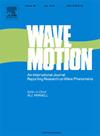含分数阶导数的多孔粘弹性介质在焊接和松散边界条件下弹性波传播综合建模
IF 2.5
3区 物理与天体物理
Q2 ACOUSTICS
引用次数: 0
摘要
地球物质的复杂性和多样性给地震探测技术带来了巨大的挑战,特别是在石油和天然气勘探中。多孔流体粘弹性理论和微观流动理论的发展和应用,使弹性波传播信息的分析成为检测的主要方法之一。本文研究了弹性波在夹层结构中的传播特性,夹层结构由弹性层、多孔粘弹性层和粘弹性固体层相互叠加而成。采用分数阶Zener模型、Biot-squirt flow (BISQ)模型和非牛顿流体理论分别描述了固体骨架的粘弹性、多孔流体的微观流动和多孔流体的粘度。据我们所知,现有的非焊接粘结边界条件的研究尚未纳入BISQ模型和分数阶导数理论。我们的目标是解决这一关键的知识差距。模型中考虑了焊接边界条件和松散边界条件。图形表示说明了数值模拟结果。研究表明,固体框架的粘弹性、多孔流体的流动特性、焊接和松散边界条件对弹性波的传播特性有显著影响。因此,对地球材料中上述因素的研究将适当地描述地震波能量的后续耗散以及对地层结构和土壤性质的分析。本文章由计算机程序翻译,如有差异,请以英文原文为准。
Comprehensive modeling of elastic wave propagation in porous viscoelastic media incorporating fractional-order derivative under welded and loose boundary conditions
The complexity and diversity of Earth materials pose significant challenges to seismic detection techniques, especially in oil and gas exploration. The development and application of the viscoelastic theory and microscopic flow theory of porous fluids have made the analysis of elastic wave propagation information one of the main methods of detection. This study investigates the propagation characteristics of elastic waves in a sandwich structure, which comprises of layers of elastic, porous viscoelastic and viscoelastic solids, placed on top of each other. The fractional order Zener model, Biot-squirt flow (BISQ) model, and non-Newtonian fluid theory are employed to describe the viscoelasticity of the solid frame, microscopic flow of porous fluids, and viscosity of porous fluids, respectively. To our knowledge, existing studies on unwelded bonded boundary conditions have not yet incorporated the BISQ model and fractional derivative theory. We aim to address this critical knowledge gap. Both welded and loose boundary conditions have been taken into account in our model. Graphical representations illustrate the numerical simulation findings. Our study suggests that the viscoelasticity of solid frame, the flow characteristics of porous fluids, welded and loose boundary condition have significant impact on the propagation properties of elastic waves. Hence, the study of the above factors in Earth materials will appropriately describe the subsequent dissipation of seismic wave energy and the analysis of stratigraphic structures and soil properties.
求助全文
通过发布文献求助,成功后即可免费获取论文全文。
去求助
来源期刊

Wave Motion
物理-力学
CiteScore
4.10
自引率
8.30%
发文量
118
审稿时长
3 months
期刊介绍:
Wave Motion is devoted to the cross fertilization of ideas, and to stimulating interaction between workers in various research areas in which wave propagation phenomena play a dominant role. The description and analysis of wave propagation phenomena provides a unifying thread connecting diverse areas of engineering and the physical sciences such as acoustics, optics, geophysics, seismology, electromagnetic theory, solid and fluid mechanics.
The journal publishes papers on analytical, numerical and experimental methods. Papers that address fundamentally new topics in wave phenomena or develop wave propagation methods for solving direct and inverse problems are of interest to the journal.
 求助内容:
求助内容: 应助结果提醒方式:
应助结果提醒方式:


